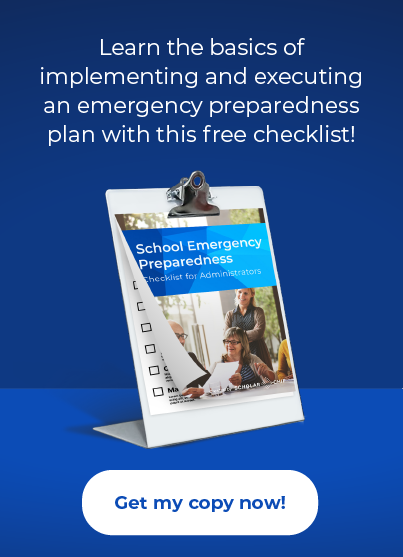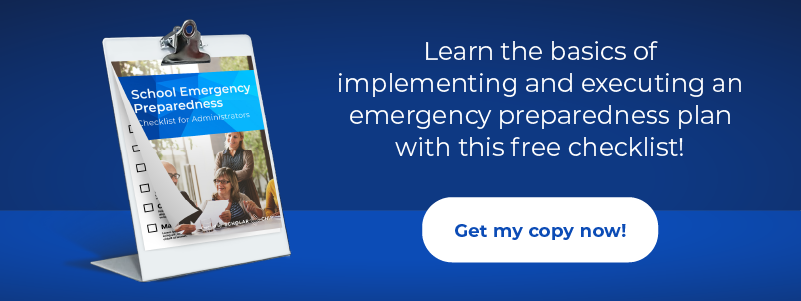Keeping students safe from various threats is part of the agreement between a school and its community and is a cornerstone responsibility of school administrators. While education is, of course, at the top of the list, safety is not far behind.
However, thinking about all the threats and hazards that can threaten a school can be overwhelming. What crises should you prepare for? Which ones are likely to happen in your area? How do you address them, and what do you need to do so?
One of the first steps in creating an emergency preparedness plan is to create a list of threats and hazards. While there are many specific scenarios that should be addressed, the types of emergency to prioritize will fall into one of eight categories.
As you think about each of the types of emergency, consider how to react during an active crisis. Not all threats can be prevented, but many can, while others can be reduced or minimized. Care should be taken to incorporate prevention strategies, along with incident management.
8 Types of Emergency Situations
Weather
Different regions have different severe weather events—it’s unlikely that you’ll need to deal with a hurricane in Montana, for instance. When preparing for weather emergencies, focus on the ones that happen in your region.
There is little that you can do to prevent a weather emergency. But you can minimize its impact and/or the danger that your students and staff face. First, identify those events that are most likely and those that are unlikely but still possible. Next, prioritize the list by the most severe or disruptive.
As you plan your emergency preparedness for severe weather, keep in mind your goals beyond student and staff safety. Will you be striving for early and clear communication, educational continuity, keeping track of students in attendance, or something else?
Natural Disasters
Like the weather, natural disasters are uncontrollable and largely unpredictable. Even so, adverse weather tends to give some sort of warning, while many natural disasters seem to come out of nowhere.
To prepare for these types of emergency situations, review historical information to ensure that you’re planning for the right things. For example, Illinois has very few earthquakes, but they aren’t unheard of. Take the time to prepare for the obvious and the unlikely but possible.
Hazmat
The risks of hazardous materials can come from a host of sources, many outside of your control. You can keep dangerous chemicals in locked closets or labs, but highway spills and industrial plant explosions are still possible and can affect your school.
When it comes to hazardous materials inside your buildings, remember that even grade schools have chemicals that can do harm, such as cleaning supplies, pesticides, or lab materials. Account for all chemicals and other hazardous materials. Confer with facility managers and science instructors to understand your safety needs and what measures are already in place.
For threats that happen outside of your school but have an impact on your location, work with local emergency response teams to understand what plans exist for the community. Emergency services, along with state and local officials, can provide you with information about potential hazards and what plans they have that you should note in your preparations.
Utility Failures
Power, sewer, and water line failures can unfortunately be common. These events are mostly outside of the control of your school. You’ll need to prepare two types of emergency plans for utilities.
The first will be for when a failure occurs while students and staff are on school grounds. The other will be when students and staff are expected but not currently in the building—for example, when a water main breaks at 5 AM on a Tuesday morning. Each situation will have a different set of preparation and response activities that should be documented and followed.
Infectious Diseases
As we’ve seen, widespread infections can have a devastating effect on our ability to maintain educational continuity, and planning for it means more than simply prepping for flu season.
Your goals for an emergency response can help guide your plans here. Keeping students learning and maintaining educational standards could be on your list of goals when dealing with an event. If that’s the case, you’ll need to add plans accordingly for distance learning, cohorting, and other strategies.
Don’t forget that prevention methods should be part of your plans as well. Cleaning schedules may help minimize the spread of infection in your school. Educational materials provided to students and families will educate them on what steps they can take to protect themselves from infections. Even the ability to quickly and easily review attendance and absence trends can facilitate prevention.
Biological Hazards
Biohazards, like hazardous materials, can exist in school labs and should be managed appropriately. Apply your hazmat protocols to biohazards in labs, and make adjustments as needed.
Biohazards can also come from contaminated food. Work with your food services manager to understand what is being done to prevent the spread of foodborne illnesses and identify potential hazards. Include food safety plans with your other emergency preparedness preparations.
Other Emergency Incidents
There are several types of threats and hazards that don’t fall into the above groups and aren’t centered on intentional violence. Things like bus accidents, accidental fires, and so on are still essential to plan for. But don’t leave out addressing smaller incidents. Even a fire localized in a single area of the school will adversely affect students and staff and can be a danger.
Prevention should be the centerpiece of your planning. Taking all precautions to prevent a fire or other accident, including proper handling of flammable materials and proper training of students and staff, goes a long way toward minimizing the threat that accidents pose.
Human-Centered Violence
Human-centered violence can be some of the most devastating but also some of the most preventable threats that you’ll need to create emergency plans around.
Modern schools must plan for dealing with such severe threats as active shooters, criminal threats, and gang violence. Reviewing things like behavior issues and absentee rates can help signal a problem that can and should be dealt with before violence enters the picture. Managing these signals promotes a positive school environment, which in and of itself helps reduce the threat of violence.
Preventing threats that come from outside the school includes strategies like limiting access to the campus. Locked doors can help and so can a visitor management system. ScholarChip’s visitor management system discreetly checks visitor information for sex offender registration and tracks pickup authorization.
Other human-centered threats are more personal, like dealing with abuse, depression, and even suicide. These types of emergency situations require offering emotional support, both as a means of prevention or after an incident has occurred. Consistently monitoring student behavior can allow support teams to intervene before an incident occurs.
Threats to schools, students, staff, and administrators come from various sources that should be addressed in your planning. When creating your emergency plans, start by looking at the likely threats and hazards that you may face, then search for solutions. Each of the types of emergency situations should have three objectives: being proactive/preventive, being mitigative, and being reactive. While having a plan of action for dealing with an active threat is important, don’t leave out prevention. It can make the need for the other objectives less likely.
ScholarChip offers holistic school safety services aligned with CDC guidelines to help schools reopen amidst growing health concerns. Through our advanced technology, built and designed for the K-12 environment, schools can identify risks and mitigate the spread of infection. Our solutions include fever screening, visitor surveys, symptom and vaccine tracking, in-school contact tracing, alerts and notifications. Learn more about our advanced COVID-19 solutions or request a reopening strategy session today!


